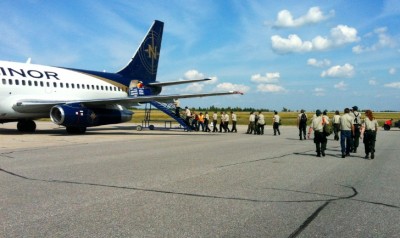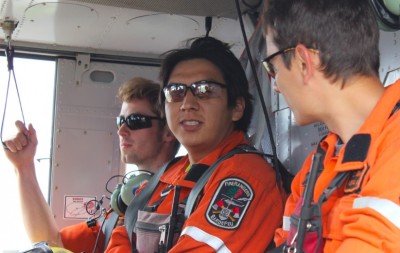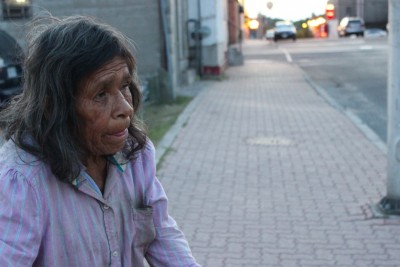 That moment when you’re standing at the Dryden airport, surrounded by a sea of tan MNRF travel shirts, brass nametags, and green Nomex pants. That moment when another white crew cab rolls up, and four crew people jump out, unloading their red and blue bags. Four new faces. Four new stories. That moment when the only seats left on the plane are middle seats, and you park yourself between two stranger rangers, and introduce yourself, asking them what base they’re from, and what their stories are. This job provides many opportunities to get to know people. To learn how to get to know people. It takes you to different parts of the province by helicopter, float plane, truck, and private airline. You go all over the country with rangers from across the province. You spend your summer working beside the same three crew members, learning their ins and outs. But on deployment, you’ll be alongside 16 new faces. You’ll have to learn new quirks, new communication styles, learn the ups and downs of these new people.
That moment when you’re standing at the Dryden airport, surrounded by a sea of tan MNRF travel shirts, brass nametags, and green Nomex pants. That moment when another white crew cab rolls up, and four crew people jump out, unloading their red and blue bags. Four new faces. Four new stories. That moment when the only seats left on the plane are middle seats, and you park yourself between two stranger rangers, and introduce yourself, asking them what base they’re from, and what their stories are. This job provides many opportunities to get to know people. To learn how to get to know people. It takes you to different parts of the province by helicopter, float plane, truck, and private airline. You go all over the country with rangers from across the province. You spend your summer working beside the same three crew members, learning their ins and outs. But on deployment, you’ll be alongside 16 new faces. You’ll have to learn new quirks, new communication styles, learn the ups and downs of these new people.
 Learning about people is something I’ve come to enjoy. I love hearing their stories. People in this job come from all over, and have all travelled a different path to get onto the same one that you are currently both standing. While some of us grew up in a small town, with three stubborn siblings, two supportive parents, one blue minivan, and a ton of hand-me-downs, others grew up in three different communities, earned two DUI’s, one high school diploma, and saw a parent wither away from a degenerative disease. And yet, here you sit, shoulder to shoulder, with someone who holds no higher or lesser rank than you, on a private plane, to go fight some fire. We are so fortunate to have exposure to many different people, and to use lessons from their stories to reflect on our own.
Learning about people is something I’ve come to enjoy. I love hearing their stories. People in this job come from all over, and have all travelled a different path to get onto the same one that you are currently both standing. While some of us grew up in a small town, with three stubborn siblings, two supportive parents, one blue minivan, and a ton of hand-me-downs, others grew up in three different communities, earned two DUI’s, one high school diploma, and saw a parent wither away from a degenerative disease. And yet, here you sit, shoulder to shoulder, with someone who holds no higher or lesser rank than you, on a private plane, to go fight some fire. We are so fortunate to have exposure to many different people, and to use lessons from their stories to reflect on our own.
It’s so heartbreaking to be woken from a deep sleep in your tent by a negative experience from your crew. To hear their voices raise, and to feel the tension heighten when they come back from late night at base camp that ended with insults and racial slurs.
“Nevermind Root, go back to bed.”
“Tell me. What’s going on.”
“Just typical. So typical. I’m sick of this shit. I’ve been dealing with it my whole life, people like him. Comments like that. I’m just sick of it.”
Racial slurs. With so many other things I’ve learned being in Kenora, racism is one that is new. Serious racism. Is that not a thing of the past yet? Name-calling. Judgment. Disrespect.
“Lazy Indians.”
“Go back to the res.”
Judging someone’s misfortunes. His situation. Her current status.
“He’s always posting that political stuff on Facebook.”
“I’m so sick of hearing his rants.”
Undermining the importance of pride? Disrespecting freedom of individuality or identity development? I completely believe that racism is a learnt behavior and attitude. No one is born with the ability to distinguish and discriminate between skin colours.
“I wanna write something about racism.”
“Oh. That. Well that’s certainly something to write about”
“Why do you think it’s even still around?”
“Just generations of treating people a certain way. You know what they say, that you aren’t born with ability to hate. That’s all taught.”
“I don’t really get it. I mean, at the end of the day, you’re just limiting your ability and opportunities to grow and learn about others and about yourself. It must be exhausting to hate some people all the time”
“Well. People are afraid.”
“What do you mean, ‘afraid’?”
“You know that quotation: ‘Fear leads to anger. Anger leads to hate. Hate leads to suffering.’ The fear just goes way back, to when Europeans first came here and met us. They were just afraid.”
Regardless of the explanation, it doesn’t justify the continued behavior. The continued state of mind. The continued judgment. A lot of the racial slurs indicate that First Nations people are lazy, or drunks. Useless contributors to society. Complaining about the past and never moving forward. Using the system to get government money for drugs and alcohol. Laughing at their homeless status.
 My first months in Kenora, I was a bit confused on how to feel. Homeless people make me feel uncomfortable—seeing them outside the grocery store in this small summer-home town was unexpected. I didn’t know how to respond when my crew would laugh and take pictures of the homeless men hanging out on the shady grass. I wasn’t sure what do when I walked into the Scotiabank late one night, and a drunk man on a high was catching some zzz’s under the window sill. And so I turned a blind eye. I ignored it. Hearing the racial slurs on work time, I just ignored it. And then they started to creep into my head. And when I would see people hanging out on that same shaded grass, in my head, I would let out a sigh of exasperation and an eye roll. And when I saw that man, dreaming in the Scotiabank, I walked across the street, and told an OPP officer. And when I was waiting my fourth hour in Emerg for stitches, and I heard the doctor questioning a sobering man what he took, lecturing him on options for how to seek help, I thought “you’re wasting your time.”
My first months in Kenora, I was a bit confused on how to feel. Homeless people make me feel uncomfortable—seeing them outside the grocery store in this small summer-home town was unexpected. I didn’t know how to respond when my crew would laugh and take pictures of the homeless men hanging out on the shady grass. I wasn’t sure what do when I walked into the Scotiabank late one night, and a drunk man on a high was catching some zzz’s under the window sill. And so I turned a blind eye. I ignored it. Hearing the racial slurs on work time, I just ignored it. And then they started to creep into my head. And when I would see people hanging out on that same shaded grass, in my head, I would let out a sigh of exasperation and an eye roll. And when I saw that man, dreaming in the Scotiabank, I walked across the street, and told an OPP officer. And when I was waiting my fourth hour in Emerg for stitches, and I heard the doctor questioning a sobering man what he took, lecturing him on options for how to seek help, I thought “you’re wasting your time.”
It’s pretty easy to absorb and assume the opinions, observations, and attitudes of the people surrounding you. But accepting a racist stance is not where I came from. I grew up with equality. So racism is a little unnatural. It makes me feel mean. Confrontation is a little unnatural. It makes me feel aggressive. But overcoming racism requires more confrontational people, to say “Hey, that’s really rude. Stop saying that.”
It’s pretty hard to deny your own observations indicating that the majority of the homeless people in Kenora are First Nations; that a lot of the post-bar fights involve someone from the reserve; that pretty much all of the people hanging out on the streets are battling a substance use problem. But, in the science world, what comes after observation? Your study doesn’t stop there. What about the analysis that follows—how you’ll interpret your own, untainted observations, in order to make reliable comparisons.
If racism really is sprouted from fear, then I can understand a bit better why it continues, despite efforts to minimize its presence. Perhaps some people choose to belittle others to feel power or strength. Furthermore, judgment is part of human nature; we rely on it for survival—is that man trustworthy? Is this food edible? The problems arise when a judgment continues with malicious intent. At this point, the judgment is doing nothing but limiting your opportunities for growth and development.
And so, as I sit, on plane with 99 other tan-shirt, MNRF employees, I’ll look around. I’ll ask questions, and I’ll listen. 99 brass tags that represent 99 different stories. Different paths. And here we are, all currently standing on the same one. In a leather seat on a Boeing 737, bound Winnipeg for fuel, then Abbotsford to go work together, shoulder to shoulder, on a BC mountainside.
Author Ariel Root is currently in Kenora in her fourth season working as a forest fire fighter for the Ontario Ministry of Natural Resources and Forestry. She has a BSc in Food Science & Nutrition from Carleton University in 2012, and is currently a graduate student in the Health Science, Technology and Policy program at Carleton University. She has been featured on APTN’s new hit TV show, Playing with Fire, Season 2.
Come back for next week’s instalment.
Photos by Ariel Root
Follow us on twitter!